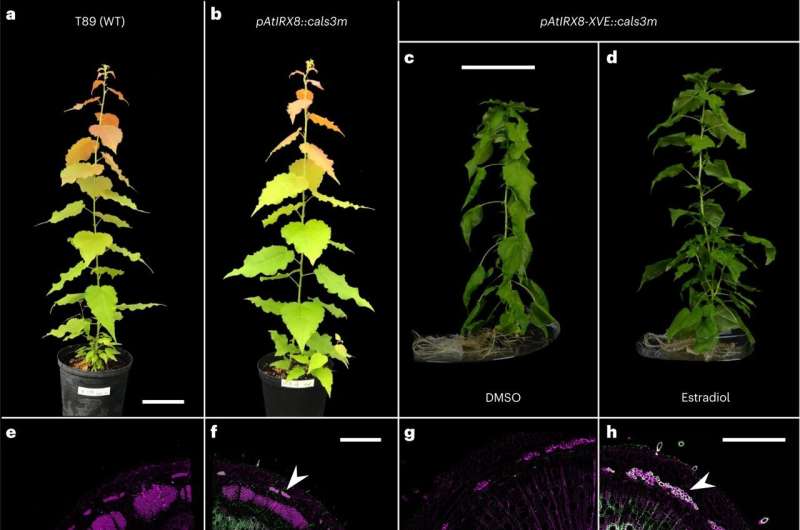This article has been reviewed according to Science X's editorial process and policies. Editors have highlighted the following attributes while ensuring the content's credibility:
fact-checked
peer-reviewed publication
trusted source
proofread
Scientists use naturally-occurring polymer to modify wood and boost biomass conversion

By adding a naturally-occurring polymer that makes wood more porous, scientists have engineered trees easier to disassemble into simpler building blocks.
Fossil fuels are the major source of energy, chemicals and many other materials, but are responsible for a substantial portion of greenhouse gas emissions. To reach carbon neutrality, much of what's made from fossil fuels today will have to be made from biomass tomorrow. With growing demand for sustainable materials and renewable energy, plant-based feedstocks have been investigated, but converting woody plant biomass to fuel and other useful products is very chemically and energetically demanding.
Until today, research into processing woody biomass to improve its efficiency of conversion to simpler components has mostly targeted the complex polymers already present in wood.
Matthieu Bourdon and colleagues have taken a different approach. They took callose, a polymer that is naturally occurring in some cell walls of plants, and successfully engineered it into the specialized secondary cell walls of plants—the wood. Published in Nature Plants, the research involving international collaborations across multiple institutes shows callose-enriched wood is much more easily converted into simple sugars and bioethanol than non-engineered wood.
Dr. Bourdon, former researcher at Sainsbury Laboratory Cambridge University (SLCU) who is now at the Friedrich Miescher Institute for Biomedical Research, first transformed the diminutive model plant, thale cress (Arabidopsis thaliana) to biosynthesize callose in its secondary walls. "We showed that the plants could accommodate a new polymer in their secondary cell walls without any negative impact on growth," he said.
Engineering trees to be a more efficient and sustainable feedstock for biomass conversion
Switching to a fast-growing tree, the deciduous Hybrid Aspen Poplar (Populus tremula x tremuloides), the team found callose-enriched wood showed interesting new properties, like an increased hygroscopicity and porosity, which makes the polymers more accessible for extracting and converting into simpler building blocks like sugars or bioethanol.
"Understanding the ultrastructural effects of callose addition on the engineered wood was very challenging. The cutting-edge experiments performed by Paul and Ray Dupree's teams in Cambridge and Warwick University are a cornerstone of this story. In fact, they surprisingly revealed that callose did not interact with other polymers but suggested that callose could act as a cell wall spacer attracting water," Dr. Bourdon said.
"This approach inspired us to search for answers beyond our own expertise and establish further collaborations to produce this multi-disciplinary piece of research, ranging from genetic engineering, biochemistry and structural biology to material science,"
"We foresee that our engineered wood will benefit biomaterials and biofuels production relying on biomass deconstruction and polymer accessibility, such as packaging materials or even advanced biomaterials like cellulose nanofibrils and delignified wood."
"The next step is to carry out field trials to confirm our findings and to assess the performance of the callose-enriched trees under real forestry conditions. We also hope that our finding introducing a new polymer into wood will inspire other researchers to introduce other types of polymers for tailored applications."
More information: Matthieu Bourdon et al, Ectopic callose deposition into woody biomass modulates the nano-architecture of macrofibrils, Nature Plants (2023). DOI: 10.1038/s41477-023-01459-0
Journal information: Nature Plants
Provided by University of Cambridge




















